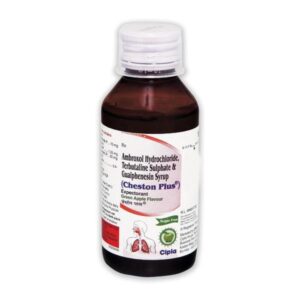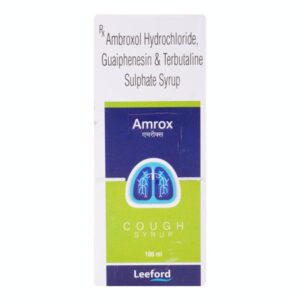AMBROXOL + GUAIPHENESIN + TERBUTALINE
Ambroxol: Ambroxol is a drug that is mainly used for its mucolytic and expectorant properties. It helps to loosen and thin mucus in the airways, making it easier to cough up. Ambroxol is commonly prescribed to treat respiratory conditions such as acute and chronic bronchitis, bronchiectasis, asthma, and other conditions characterized by the production of thick and sticky mucus.
The mechanism of action of Ambroxol involves stimulating the production and secretion of surfactant, a substance that helps to keep the airways lubricated and prevents the accumulation of mucus. It also enhances the ciliary activity of the respiratory tract, promoting the movement of mucus towards the throat, where it can be expelled through coughing.
The dose of Ambroxol can vary depending on the specific condition being treated and the age of the patient. In adults, the usual recommended dose is 30 mg to 120 mg per day, divided into 2 to 3 doses. For children, the dosage should be adjusted according to their age and weight. It is important to follow the instructions of the healthcare professional and not exceed the recommended dose.
Like any medication, Ambroxol can have side effects, although they are usually mild and transient. The most commonly reported side effects include gastrointestinal disturbances such as nausea, vomiting, and diarrhea. Rare side effects may include allergic reactions, such as skin rash or itching. In very rare cases, severe allergic reactions such as angioedema or anaphylaxis may occur and require immediate medical attention.
It is important to note that Ambroxol should not be used without medical supervision, especially in individuals with a history of hypersensitivity or allergic reactions to the drug. Pregnant or breastfeeding women should consult their healthcare provider before using Ambroxol. Additionally, it may interact with certain medications, so it is important to inform the healthcare provider about all other medications being taken.
Guaiphenesin: Guaifenesin is an expectorant drug that helps to loosen and thin mucus in the airways. It is primarily used to relieve symptoms of respiratory conditions such as coughs, chest congestion, and bronchitis.
The mechanism of action of guaifenesin is not fully understood. It is believed to work by increasing the volume and reducing the viscosity of respiratory tract secretions, making it easier for the body to expel mucus. This helps to alleviate cough and congestion.
Guaifenesin is available in various forms, including tablets, capsules, and liquids. The recommended dose for adults and children (12 years and older) is typically 200 to 400 mg every four hours, not exceeding 2.4 grams in a 24-hour period. For children aged 6 to 12 years, the dose is usually 100 to 200 mg every four hours, not exceeding 1.2 grams in a 24-hour period. It is important to follow the dosing instructions provided by a healthcare professional or on the product label.
Some common side effects of guaifenesin may include nausea, vomiting, drowsiness, headache, dizziness, and stomach upset. These side effects are usually mild and resolve on their own. However, if these side effects persist or worsen, it is advisable to consult a healthcare professional.
It is important to note that guaifenesin should not be used in conjunction with certain medications or in individuals with specific medical conditions such as asthma, liver disease, or kidney disease, without consulting a healthcare professional. Additionally, this drug may not be suitable for pregnant or breastfeeding women, so it is important to consult a healthcare professional before use in these cases as well.
Overall, guaifenesin is a commonly used expectorant drug that helps to relieve symptoms of respiratory conditions. However, it is always best to consult with a healthcare professional for appropriate use and dosage instructions, as well as to address any concerns or potential interactions with other medications or pre-existing medical conditions.
Terbutaline: Terbutaline is a medication that belongs to a group of drugs called beta-2 adrenergic agonists. It is primarily used to treat bronchospasm associated with asthma, chronic obstructive pulmonary disease (COPD), and other respiratory conditions.
The main mechanism of action of terbutaline is through its stimulation of beta-2 adrenergic receptors in the smooth muscles of the airways. This activation leads to relaxation and dilation of the bronchial passages, thereby relieving bronchospasm and improving airflow to the lungs.
Terbutaline is available in various forms, including tablets, syrups, and inhalers. The dosage may vary depending on the patient’s age, condition, and the formulation used. It is typically administered orally at a dose of 2.5 mg to 5 mg, three times a day. For acute asthma attacks, a higher dosage or nebulized form may be used under medical supervision.
While terbutaline is generally considered safe and effective, it can cause certain side effects. Common side effects include tremors, headache, dizziness, nervousness, and increased heart rate. These effects are usually mild and temporary. However, if they persist or become severe, it is important to consult a healthcare professional.
In rare cases, terbutaline may cause more serious adverse effects, such as chest pain, palpitations, high blood pressure, muscle cramps, and allergic reactions. It is essential to seek immediate medical attention if these symptoms occur.
As with any medication, it is crucial to follow the prescribed dosage and instructions provided by the healthcare provider. Terbutaline should not be used as a rescue medication for sudden severe asthma attacks, and a doctor should be consulted for proper management in such cases.



